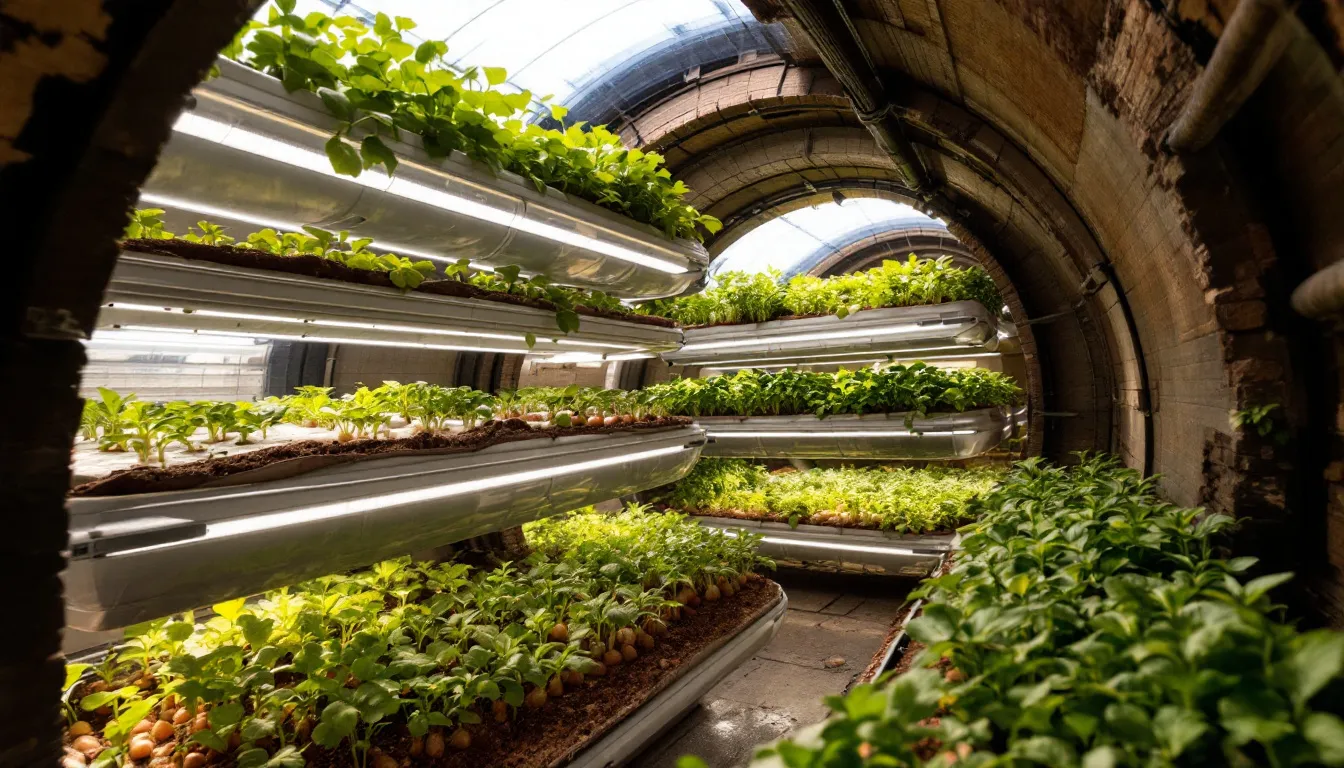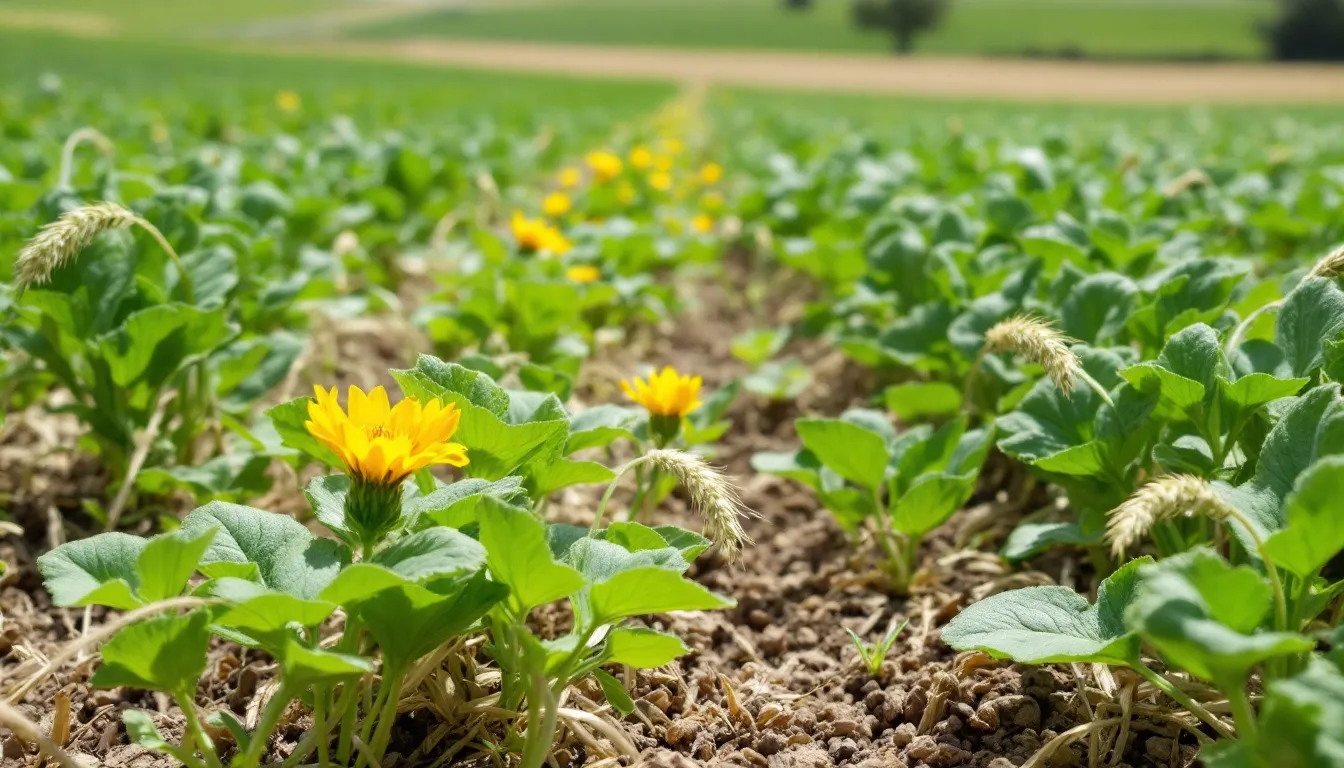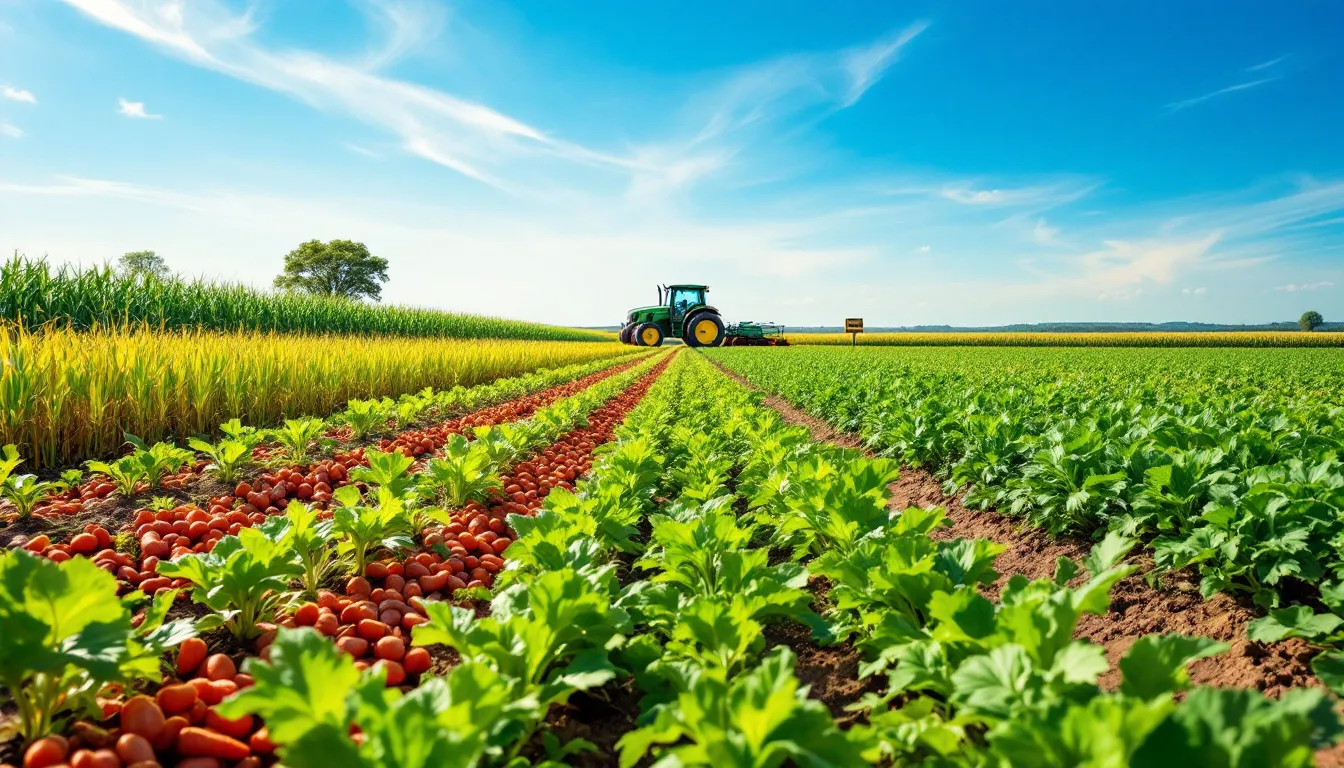
Introduction to Multi-Layer Farming
Multi-layer farming is a sustainable and innovative approach to crop production that has been gaining attention among farmers increasingly interested in maximizing land use efficiency. This farming system involves cultivating multiple crops simultaneously on the same piece of land. One of the most intriguing applications of multi-layer farming is the cultivation of underground economy root crops, particularly in a five-layer system. These systems not only improve root growth and crop yields but also significantly enhance soil health.
By utilizing underground layers effectively, farmers can grow root crops such as sweet potatoes, carrots, radishes, and sugar beets, while simultaneously promoting biodiversity and soil conservation. This approach minimizes soil erosion, optimizes root development, and enhances water and nutrient uptake, contributing to sustainable agricultural practices.
Why Multi-Layer Farming Works
The primary reason multi-layer farming is so effective lies in its ability to mimic natural ecosystems. In the wild, plant roots grow in diverse, multi-tiered systems, with fibrous root systems spreading across the soil surface and tap roots penetrating deep. By replicating this natural arrangement, most farmers can maximize the use of both horizontal and vertical space. This system allows for the growth of multiple crops, including root crops, which thrive when root architecture and root growth angle are optimized.
Benefits of Multi-Layer Farming:
-
Enhanced Crop Yields: Improved root system architecture promotes nutrient uptake and root penetration.
-
Soil Health Improvement: Cover crops and reduced tillage improve organic matter and reduce soil compaction.
-
Reduced Soil Erosion: Multi-layer planting protects the soil surface from erosion.
-
Increased Biodiversity: Growing more than one crop improves ecosystem stability.
Understanding Root System Architecture
Root system architecture is crucial for the success of underground economy root crops. Understanding crop roots and their architecture is essential for optimizing crop resilience and yield. It includes factors like root length, root diameter, root growth angle, and the distribution of fine roots and crown roots within the soil. Root diameter is a crucial factor in promoting efficient water absorption, especially under drought conditions. The structure and organization of the root system significantly affect water and nutrient uptake efficiency, crop growth, and overall plant health. Root hairs play a vital role in enhancing nutrient absorption by increasing the root surface area. Additionally, the root tip’s growth angle and depth direction are influenced by gravitropism and hydrotropism, which are important for optimizing root architecture to enhance drought resilience.
Root System Types:
-
Fibrous Root System: Found in crops like corn, characterized by numerous fine roots that remain close to the soil surface.
-
Tap Root System: Seen in crops like carrots, where a primary root penetrates deeply into the soil.
-
Adventitious Roots: Develop from non-root tissues, such as the crown roots in rice plants.
-
Nodal Roots: Common in cereals, arising from stem nodes.
Factors Influencing Root System Architecture:
-
Genetic Mechanisms: The genetic makeup of a plant determines its root growth patterns, including root gravitropism and root growth angle.
-
Soil Conditions: Soil texture, compaction, and organic matter significantly impact root length and root architecture.
-
Environmental Factors: Weather patterns, such as rainfall and temperature, influence root growth and nutrient uptake.
Case Study: Root Architecture in Different Crops
A comparative study of root system architectures in carrots and radishes revealed that carrots, with their deep tap roots, showed greater root penetration and water uptake in sandy soils, while radishes, with a more fibrous system, thrived better in loamy soils. This indicates the importance of matching root crop selection with soil types for optimal yield.
Soil Health and Its Importance
Soil health is the foundation of productive agriculture. The plant cell environ plays a crucial role in soil health by influencing the adaptability of root systems to various environmental stresses, which in turn affects plant growth and nutrient uptake. Fertile soil with a balanced microbial ecosystem ensures that plant roots have access to essential nutrients and water throughout the entire growing season, significantly impacting plant growth. Soil organisms like mycorrhizal fungi are essential for facilitating nutrient uptake and maintaining soil structure. Poor soil conditions, including soil compaction and low organic matter, can drastically reduce crop yields.
Key Strategies to Improve Soil Health:
-
Cover Cropping: Using green manures and legumes to fix nitrogen and enhance organic matter.
-
Reduced Tillage: Minimizes soil disturbance and maintains root zone integrity.
-
Crop Rotation: Reduces pest cycles and promotes diverse root systems.
-
Soil Amendments: Adding compost or organic mulch to boost microbial activity and improve soil structure.
The Role of Cover Crops in Multi-Layer Farming

Cover crops are integral to multi-layer farming systems, especially for underground economy root crops. Radish seeds are often used as cover crops due to their ability to break up compacted soil and enhance nutrient cycling. They protect the soil surface, reduce soil erosion, and improve soil health by cycling nutrients and adding organic matter. Cover crops like cereal rye are particularly effective in northern regions where soil erosion and compaction are significant concerns.
Cover Crop Integration Strategies:
-
Intercropping with Root Crops: Planting cover crops between rows of root crops to maintain soil cover.
-
Seasonal Cover Crop Rotation: Using different cover crops across seasons to maintain soil fertility.
Crop Selection for Optimal Root Development
Selecting the right crops is crucial for multi-layer farming. Rice roots play a vital role in this system, as advanced visualization and modeling techniques help optimize the root system architecture (RSA) for better resource utilization. Deep-rooted crops like alfalfa and radishes help break up compacted soils, while shallower-rooted plants like lettuce make efficient use of the upper soil layers. The significance of underground roots in soil health cannot be overstated, as they contribute to soil structure and nutrient cycling. Integrating tuber crops and fibrous root crops ensures that the entire root system efficiently exploits soil resources.
Case Study: Integrating Root Crops in Multi-Layer Systems
Farmers in tropical regions have successfully integrated cassava, sweet potatoes, and groundnuts in five-layer systems. These crops, with their diverse root architectures, collectively reduce soil erosion and enhance nutrient cycling.
Five Layer Systems and Root Crops
The five-layer system is a revolutionary approach to farming that maximizes the use of vertical and horizontal space by growing multiple crops together. Root crops, such as sweet potatoes, sugar beets, and tubers, are integral to this system due to their unique root system architecture. These crops grow underground, breaking up compacted soil and bringing nutrients from deeper layers to the surface. This not only improves soil health but also reduces soil erosion and increases crop yields.
For instance, incorporating cereal rye as a cover crop in the third layer provides multiple benefits. It offers ground cover, suppresses weeds, and fixes nitrogen, all while improving soil health and reducing soil compaction. By integrating root crops into the five-layer system, farmers can create a more resilient and productive farming environment, ensuring sustainable crop production throughout the entire growing season.
Improving Root Development through Best Practices
Root development is a cornerstone of successful crop production. To enhance root growth, farmers can adopt several best practices. Reduced tillage, for example, minimizes soil disturbance, preserving the root zone and promoting deeper rooting. Crop rotation helps break pest cycles and promotes diverse root systems, while cover crops improve soil health by adding organic matter and reducing soil compaction.
Techniques such as mulching and composting further enhance soil fertility and structure, creating an ideal environment for root growth. These practices collectively lead to increased crop yields, better nutrient uptake, and more efficient use of water and nutrients. In northern regions, where weather patterns can be challenging, crops with deeper rooting systems have shown greater resilience, further underscoring the importance of robust root development practices.
Economic Benefits of Multi-Layer Farming
Multi-layer farming offers substantial economic benefits by allowing farmers to grow multiple crops simultaneously. This approach not only increases overall crop yields but also reduces soil erosion and promotes soil health, leading to long-term sustainability. By reducing the need for synthetic fertilizers and pesticides, farmers can save on input costs, making their operations more profitable.
Moreover, multi-layer farming provides crop diversity, which helps spread risk and opens up new market opportunities. For example, studies have shown that corn yields can increase by up to 20% when using a multi-layer approach, while also improving soil health and reducing erosion. This method is particularly beneficial for growing many vegetables, including root crops, making it a versatile and profitable farming system.
Measuring Success in Multi-Layer Farming
Success metrics for multi-layer farming include improved crop yields, reduced soil erosion, and enhanced soil health. Regular soil testing and crop monitoring help farmers make informed decisions about crop selection, root development, and soil management.
Example Metrics to Track:
|
Metric |
Measurement Method |
|---|---|
|
Crop Yields |
Weight per hectare |
|
Soil Health |
Organic matter percentage |
|
Root Development |
Root length density |
|
Environmental Impact |
Soil erosion rates |
Addressing Global Challenges through Sustainable Farming
Sustainable farming practices, such as multi-layer farming and the use of cover crops, are essential in addressing global challenges like soil erosion, climate change, and food insecurity. By enhancing soil health, reducing reliance on synthetic inputs, and increasing crop diversity, these practices help mitigate climate change effects, improve water quality, and promote resource efficiency.
For instance, sustainable farming can significantly boost crop yields, reduce poverty, and enhance food security, especially in developing regions. A study on small-scale farmers in Africa demonstrated that sustainable practices could increase crop yields by up to 50%, while also improving soil health and reducing poverty. By adopting these practices, farmers can contribute to a more sustainable food system and address pressing global challenges.
Getting Started with Multi-Layer Farming
To begin multi-layer farming, assess soil conditions, select suitable root crops, and develop a cropping system that balances root depth and diversity. Plant sci plays a crucial role in developing best practices for multi-layer farming by addressing challenges such as abiotic stress and improving crop yields. Incorporating ground cover, like rice straw, can further enhance soil moisture retention and reduce compaction.
Conclusion and Recommendations

In conclusion, integrating root crops into multi-layer farming systems offers numerous benefits, including improved soil health, increased crop yields, and reduced soil erosion. To promote these practices, farmers should consider the following strategies:
-
Incorporate Root Crops: Use root crops to enhance soil health and reduce soil compaction.
-
Use Cover Crops and Reduced Tillage: These practices promote soil health and reduce the need for synthetic inputs.
-
Adopt Multi-Layer Farming: Increase crop diversity and resource efficiency through multi-layer farming approaches.
-
Implement Sustainable Practices: Use organic amendments and crop rotation to improve soil health and reduce environmental impacts.
Further research into the genetic mechanisms underlying root growth and development, as well as the benefits of mycorrhizal fungi for nutrient uptake efficiency, will continue to advance sustainable farming practices. By adopting these strategies, farmers can help create a more sustainable food system, improve soil health, and increase crop yields, addressing global challenges like climate change and food insecurity.
Conclusion
Multi-layer farming offers a practical solution to sustainable agriculture, especially when focused on underground economy root crops. By prioritizing soil health, selecting diverse crops, and optimizing root system architecture, farmers can boost yields while minimizing environmental impacts. Accurately locating root tips is crucial in optimizing root system architecture for sustainable farming. Adopting these practices contributes to a resilient and productive farming system, addressing global challenges like climate change and food insecurity.
For more insights on sustainable farming, visit FAO’s Sustainable Agriculture and learn more about soil health at Soil Health Institute.
